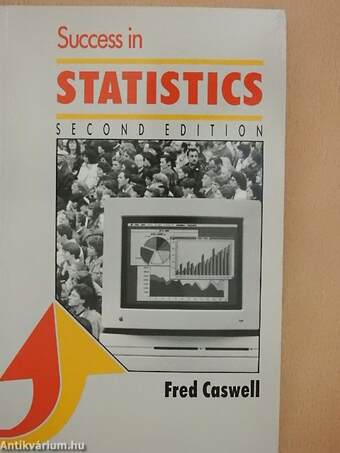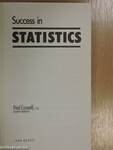1.034.815
kiadvánnyal nyújtjuk Magyarország legnagyobb antikvár könyv-kínálatát

VISSZA
A TETEJÉRE
JAVASLATOKÉszre-
vételek
Success in Statistics
| Kiadó: | John Murray |
|---|---|
| Kiadás helye: | London |
| Kiadás éve: | |
| Kötés típusa: | Ragasztott papírkötés |
| Oldalszám: | 356 oldal |
| Sorozatcím: | |
| Kötetszám: | |
| Nyelv: | Angol |
| Méret: | 21 cm x 14 cm |
| ISBN: | 0-7195-4708-3 |
| Megjegyzés: | Néhány fekete-fehér ábrával. |
naponta értesítjük a beérkező friss
kiadványokról
naponta értesítjük a beérkező friss
kiadványokról
Fülszöveg
SECOND E D I T I 0 N Success in Statistics gives a clear and concise explanation of basic statistical methods and demonstrates the importance and application of statistics in many diverse fields, including fináncé, marketing, management, economies, and science. The first eleven units deal with the techniques required by most introductory courses, including BTEC National, GCSE, and first Professional courses. Data collection, index numbers (including the construction of the Retail Prices Index), and time-series analysis are particularly thoroughly covered. The following six units contain material essential for more advanced courses and a discussion of interest and investment appraisal which will be especially useful to students of business and accountancy. For the second edition a new final unit on 'Computers and statistics' has been added, which will be of interest to all statistics students. Worked examples and exercises (with answers where appropriate) are included throughout, and... TovábbFülszöveg
SECOND E D I T I 0 N Success in Statistics gives a clear and concise explanation of basic statistical methods and demonstrates the importance and application of statistics in many diverse fields, including fináncé, marketing, management, economies, and science. The first eleven units deal with the techniques required by most introductory courses, including BTEC National, GCSE, and first Professional courses. Data collection, index numbers (including the construction of the Retail Prices Index), and time-series analysis are particularly thoroughly covered. The following six units contain material essential for more advanced courses and a discussion of interest and investment appraisal which will be especially useful to students of business and accountancy. For the second edition a new final unit on 'Computers and statistics' has been added, which will be of interest to all statistics students. Worked examples and exercises (with answers where appropriate) are included throughout, and there are alsó suggestions for assignments to emphasize the practical applications of the subject matter. Jhe data on which examples are based have been updated for the | second edition. 1 I Cover photographs repród uced by courtesy of Apple Computer UK Ltd and Barnaby's Picture Library. 1 VisszaTartalom
Unit 1 Introduction to Statistics1.1 Why Statistics Matter
i
1.2 The Meaning of Statistics
1.3 The Growth and Importance of Statistics
1.4 Statistics and the Business World
1.5 Misuse of Statistics
1.6 Using this Book
Unit 2 The Collection of Data
2.1 Populations
2.2 Problems of Bias
2.3 Sampling Frames
2.4 Sampling Methods
2.5 Survey Preliminaries
2.6 Collecting the Data
2.7 The Design of Questionnaires
2.8 Pilot Surveys
2.9 Errors from Sampling
2.10 Exercises
Unit 3 Secondary Data
3.1 Introduction
3.2 The Dangers of Secondary Data
3.3 Official UK Statistical Sources
3.4 The Business Statistics Office
3.5 Publications of the European Economic Community
3.6 Exercises
Unit 4 Variables and Frequency Distributions
4.1 Variables Defined
4.2 Frequency Distributions
4.3 The Classification of Data
4.4 Class Limits and Class Boundaries
4.5 Open-ended Classes
4.6 Graphical Representation of a Frequency Distribution
4.7 Exercises
Unit 5 Presentation of Data
5.1 Introduction
5.2 Reports
viii Contents
5.3 Tables
5.4 Rules íor Tabulation
5.5 Diagrams and Charts
5.6 Graphs
5.7 Exercises
Unit 6 Approximation and Error 72
6.1 Introduction ^2
6.2 Rounding and Signifícant Figures 72
6.3 Truncation ^4
6.4 Unbiased or Compensating Errors 74
6.5 Biased or Cumulating Errors 75
6.6 Absolute and Relatíve Errors 76
6.7 Calculating with Approximations 76
6.8 Exercises 78
Unit 7 Measures of Central Tendency or Location: A verages 81
7.1 The Purpose of A verages 81
7.2 The Arithmetic Mean 81
7.3 Introduction to Formuláé 81
7.4 The Arithmetic Mean of a Frequency Distribution 82
7.5 The Arithmetic Mean of a Grouped Frequency Distribution 84
7.6 The Assumed Mean or Short-cut Method 84
7.7 Characteristics of the Arithmetic Mean 87
7.8 The Mode 87
7.9 The Medián 89
7.10 The Medián of a Grouped Frequency Distribution 90
7.11 The Relationship between the Arithmetic Mean, the Medián and
the Mode 92
7.12 The Geometric Mean 94
7.13 The Harmonic Mean 95
7.14 Exercises 07
Unit 8 Measures of Dispersion and Measures of Skewness 100
8.1 Why Measure Dispersion? jqq
8.2 The Rangé jqj
8.3 The Quartile Deviation or Semi-interquartile Rangé 102
8.4 Deciles and Percentiles jq^
8.5 The Mean Deviation ^
8.6 The Standard Deviation ^
8.7 The Standard Deviation of a Frequency Distribution j j q
8.8 The Standard Deviation of a Grouped Frequency Distribution 113
8.9 The Standard Deviation and the Normál Distribution j 14
8.10 Z Scores ^
8.11 Measures of Skewness jjg
8.12 Exercises jjg
Unit 9 The Relationship between Two Variables 122
9.1 Introduction 122
9.2 Scatter Diagrams 122
9.3 Regression Analysis 125
9.4 Estimating with Regression Lines 131
9.5 Correlation 133
9.6 The Interpretation of the Correlation Coetticient 136
9.7 Rank Correlation 137
9.8 Exercises 139
Unit 10 Index Numbers 143
10.1 Introduction 143
10.2 Simple Index Numbers 144
10.3 Weighted Index Numbers 146
10.4 Quantity or Volume Index Numbers 150
10.5 Formuláé for Index Numbers 153
10.6 The Practical Problems of Index Number Construction 154
10.7 Changing the Base of an Index 155
10.8 A Chain Base Index 155
10.9 The Retail Price Index 156
10.10 Economic Lndicators other than the RPI 161
10.11 Exercises 164
Unit 11 The Analysis of Time Series 166
11.1 Introduction 166
11.2 Estimation of the Trend 168
11.3 Models of Time Series 175
11.4 Seasonal Analysis 175
11.5 Residual Variations 180
11.6 Deflation of Time Series 181
11.7 ZCharts 183
11.8 Exercises 185
Unit 12 An Introduction to Probability 188
12.1 Measuring Probability 188
12.2 TheAdditionRule 190
12.3 The Multiplication Rule 192
12.4 The General Addition Rule 193
12.5 The General Multiplication Rule 195
12.6 Exercises 197
Unit 13 Probability Distributions 199
13.1 Introduction 199
13.2 Observed and Expected Frequencies 200
13.3 The Binomial Distribution 202
13.4 The Poisson Distribution 207
x Contents
13.5 The Normál Distribution 209
13 6 The Relationship between the Normál, Binomial and Poisson
Distributions 211
13.7 Expected Values 214
13.8 Exercises 216
13.9 Appendix 218
Unit 14 Sampling Theory 219
14.1 Introduction 219
14.2 The Sampling Distribution ofthe Arithmetic Mean 219
14.3 Sums and Differences of Random Variables 224
14.4 Sampling Distribution of the Difference between Two Means 227
14.5 Attribute Sampling 229
14.6 Exercises 234
Unit 15 Significance Testing 236
15.1 Introduction 236
15.2 Tests Concerning Means 237
15.3 Tests Concerning Proportions 243
15.4 The t Distribution 246
15.5 Chi-squared (f) Tests 252
15.6 Statistical Quality Control 258
15.7 Exercises 263
Unit 16 Interest and Investment Appraisal 267
16.1 Introduction 267
16.2 Simple Interest 267
16.3 Compound Interest 268
16.4 Investment Appraisal 270
16.5 The Pay-back Method 272
16.6 The Average Rate of Return Method 272
16.7 The Net Present Value Method 273
16.8 The Internál Rate of Return Method ?76
16.9 Other Considerations 277
16.10 Exercises 278
Unit 17 Population Statistics
17.1 Introduction ^^
17.2 Vitai Registration ~gQ
17.3 The Decennial Population Census
17.4 Demographic Rates ~
17.5 Exercises ^
Unit 18 Computers and Statistics ^93
18.1 Introduction 293
18.2 The Computer 293
Contents xi
18.3 Computer Hardware 293
18.4 Computer Software 294
18.5 The Computer and the Statistician 295
18.6 Statistical Packages 298
18.7 Spreadsheets 300
18.8 Database Packages 304
18.9 The CSO Databank 304
Suggestions for Projects 305
Further Reading 324
Answers to Exercises 325
Tables: A Logarithms 330
B Antilogarithms 332
C Square Roots 334
D Proportions ofArea under the Normál Curve 338
E Values 340
F Studenfs t Distribution 341
G x2 Distribution 342
H Random Sampling Numbers 343
I Present Values ofLl 344
J Conversion of Rangé to Standard Deviation 346
Index
347
Témakörök
- Közgazdaságtan > Számvitel, elemzés
- Idegennyelv > Idegennyelvű könyvek > Angol > Egyéb
- Idegennyelv > Idegennyelvű könyvek > Angol > Természettudományok > Matematika
- Idegennyelv > Idegennyelvű könyvek > Angol > Közgazdaságtan > Számvitel, elemzés
- Természettudomány > Matematika > Idegennyelvű
- Természettudomány > Matematika > Statisztika
- Természettudomány > Matematika > Tankönyvek > Felsőfokú
- Természettudomány > Matematika > Társtudományok > Egyéb
- Közgazdaságtan > Tankönyvek, jegyzetek, szöveggyűjtemények > Felsőoktatási
- Idegennyelv > Idegennyelvű könyvek > Angol > Közgazdaságtan > Tankönyvek, jegyzetek, szöveggyűjtemények > Felsőoktatási
- Tankönyvek, jegyzetek, szöveggyűjtemények > Közgazdaságtudomány > Felsőoktatási
- Tankönyvek, jegyzetek, szöveggyűjtemények > Természettudományok > Matematika
- Tankönyvek, jegyzetek, szöveggyűjtemények > Természettudományok > Matematika > Felsőfokú











